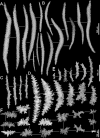Neospongodes atlantica, a potential case of an early biological introduction in the Southwestern Atlantic
- PMID: 36540794
- PMCID: PMC9760029
- DOI: 10.7717/peerj.14347
Neospongodes atlantica, a potential case of an early biological introduction in the Southwestern Atlantic
Abstract
Soft corals (Anthozoa: Octocorallia) are discreet components in the Southwestern Atlantic reef communities. In Brazil, the native octocoral shallow-reef fauna is mostly represented by gorgonians. Consequently, except for the nephtheid Neospongodes atlantica, most of the known soft corals from this region are considered non-indigenous. Hitherto, the monotypic genus Neospongodes, which was proposed in the early 1900s, has been considered to be endemic to the Northeastern Brazilian coast. Herein, based on in situ records, we show that N. atlantica is a substrate generalist that has been probably expanding its distribution by dominating extensive shallow and mesophotic sandy and reef bottoms, generally outcompeting other reef benthic organisms, including Brazilian endemic species. Based on previously unidentified museum specimens, new records, and a broad literature review, we provide the most comprehensive modelling of the potential distribution of this species in the Southwestern Atlantic. Based on molecular inference supported by in-depth morphological analysis, the probable non-indigenous and, therefore, ancient introduction of N. atlantica in Brazilian waters is discussed. Finally, these results support that Neospongodes and the Indo-Pacific Stereonephthya are synonyms, which led us to propose the latter as taxonomically invalid.
Keywords: Brazil; Continental shelf; Habitat Modelling; Invasion; Octocorallia; Soft-bottom.
©2022 Cordeiro et al.
Conflict of interest statement
Leonardo HU Monteiro is employed by Grupo Sandmine & Inframar. The authors declare there are no competing interests.
Figures








References
-
- Allam K, Khedr A, Allam A, Abdelkader M, Elkhayat E, Fouad M. Chemical and biological diversity in Nephthea soft corals in the current decade: a review. Journal of advanced Biomedical and Pharmaceutical Sciences. 2021;4(3):124–133. doi: 10.21608/jabps.2021.62966.1121. - DOI
-
- Anderson RP, Raza A. The effect of the extent of the study region on GIS models of species geographic distributions and estimates of niche evolution: preliminary tests with montane rodents (genus Nephelomys) in Venezuela. Journal of Biogeography. 2010;37:1378–1393. doi: 10.1111/j.1365-2699.2010.02290.x. - DOI
-
- Assis J, Tyberghein L, Bosch S, Verbruggen H, Serrão EA, De Clerck O. Bio-ORACLE v2.0: Extending marine data layers for bioclimatic modelling. Global Ecology and Biogeography. 2018;27:277–284. doi: 10.1111/geb.12693. - DOI
-
- Barve N, Barve V. ENMGadgets: tools for pre and post processing in ENM workflows. 2013. https://github.com/vijaybarve/ENMGadgets https://github.com/vijaybarve/ENMGadgets
Publication types
MeSH terms
Associated data
LinkOut - more resources
Full Text Sources
Research Materials

